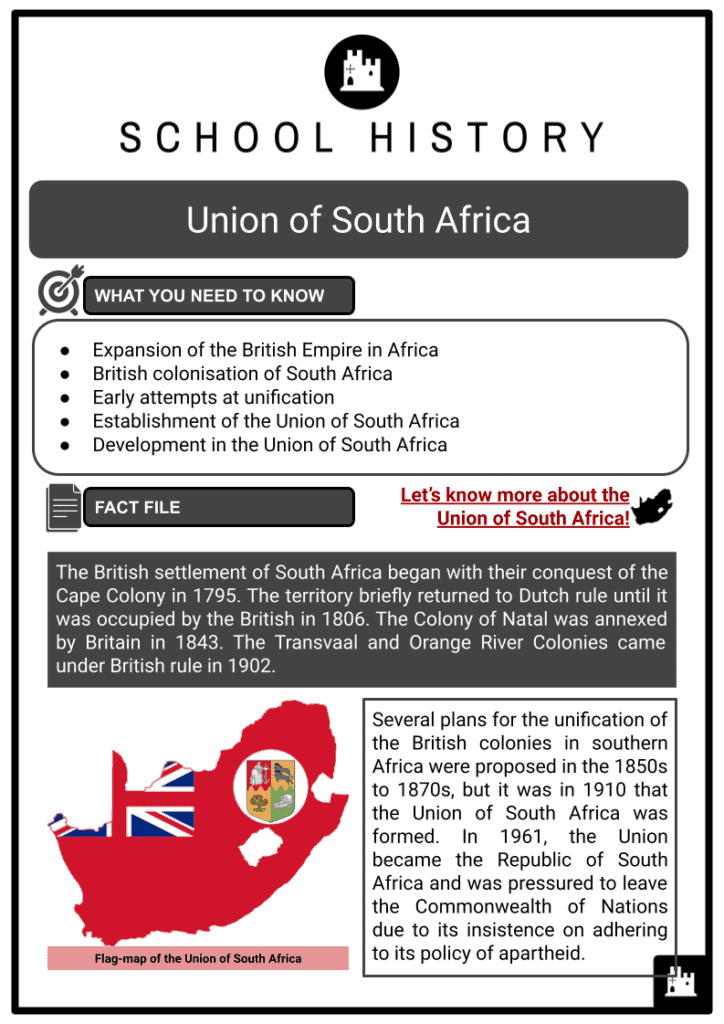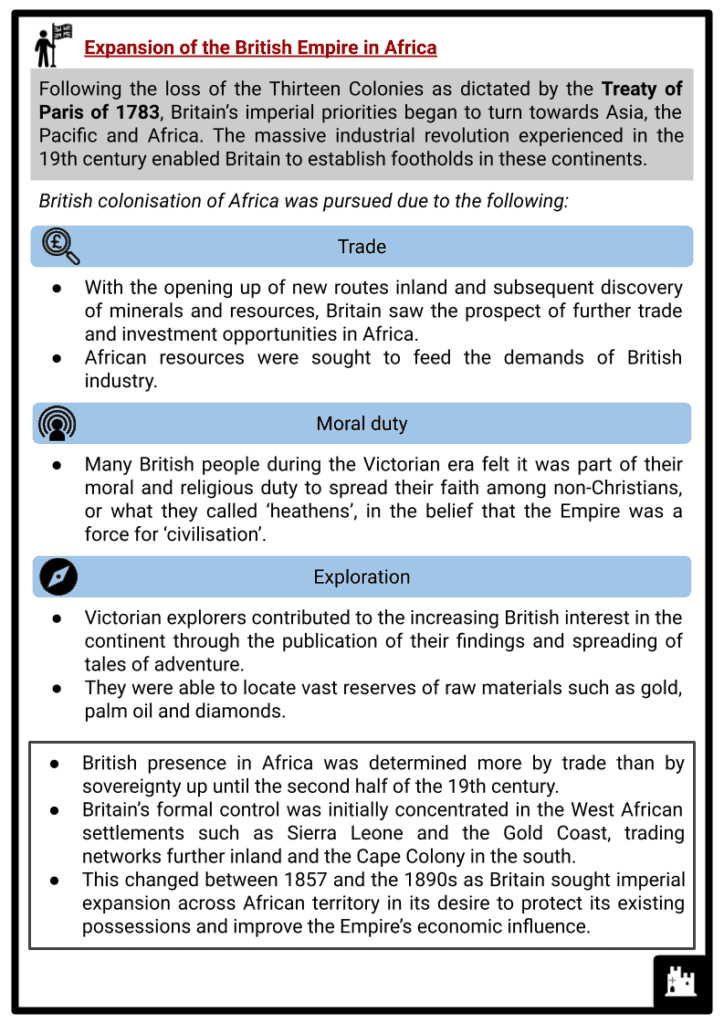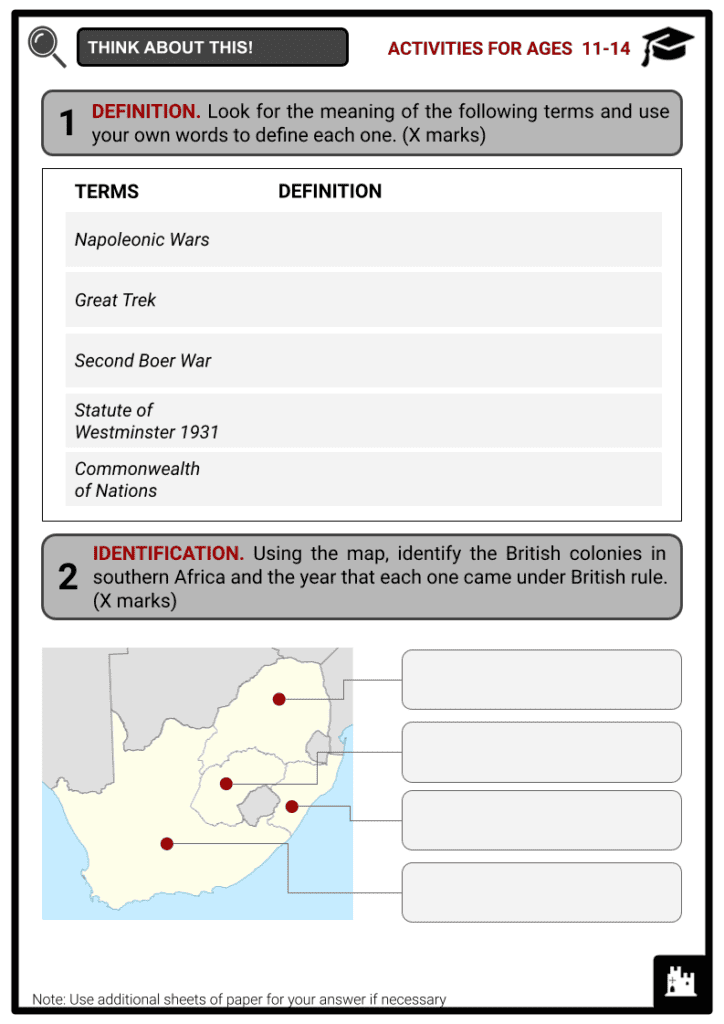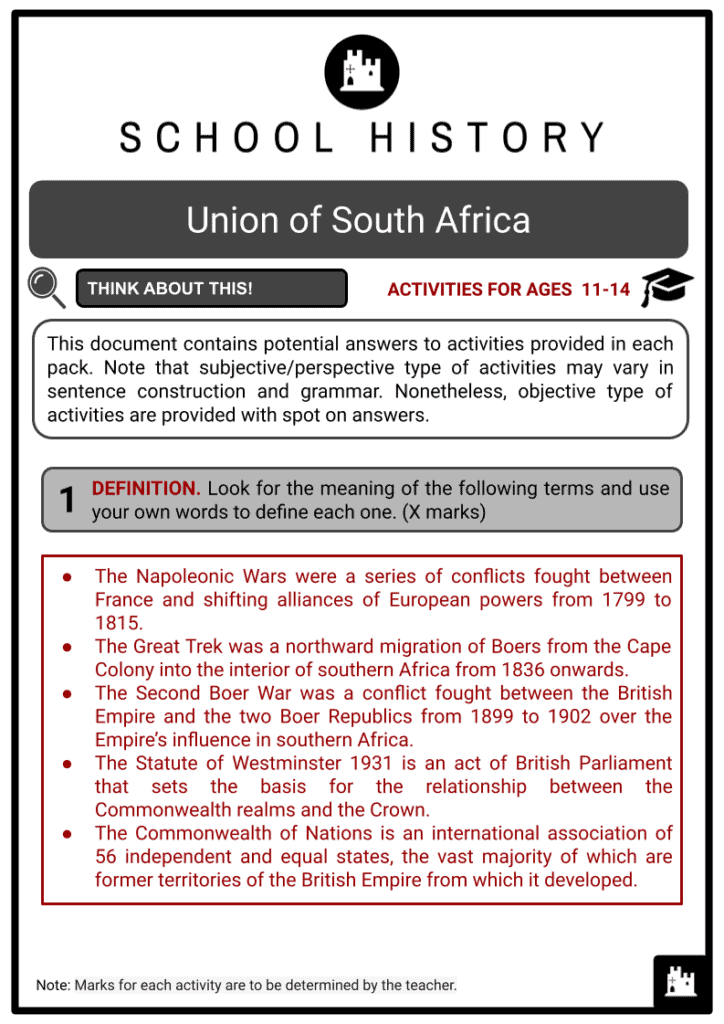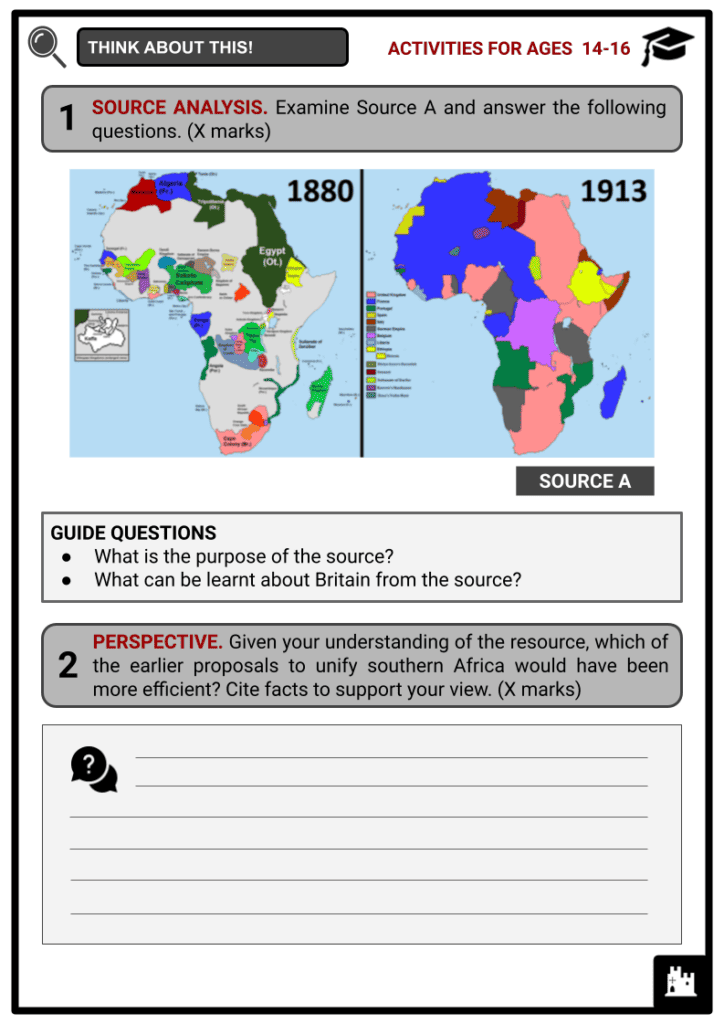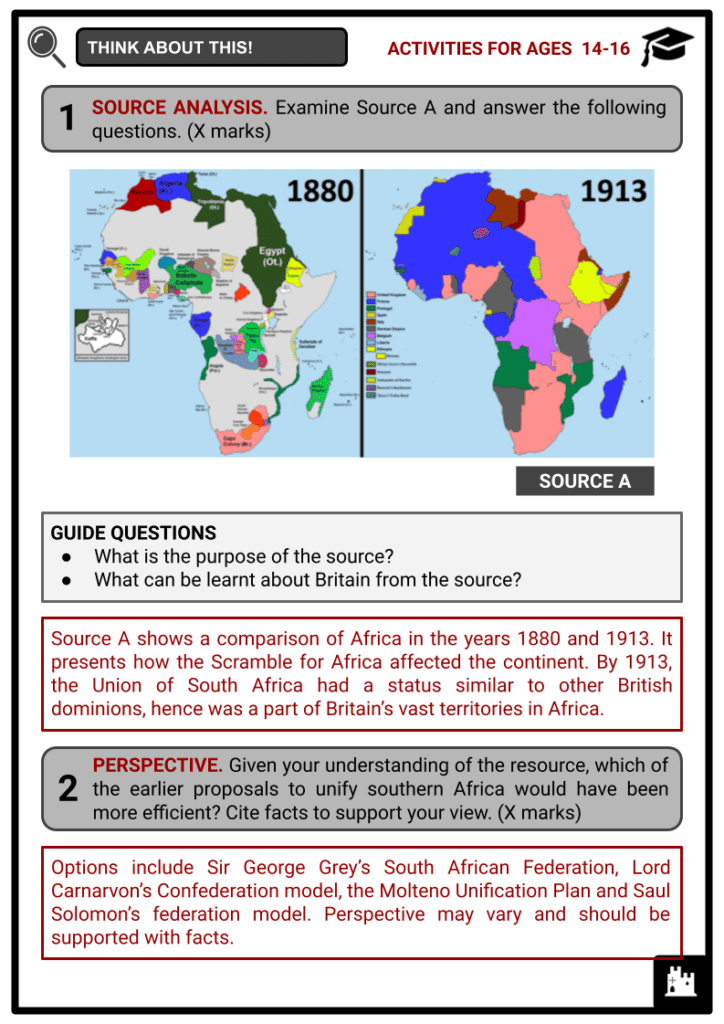Union of South Africa Worksheets
Do you want to save dozens of hours in time? Get your evenings and weekends back? Be able to teach about the Union of South Africa to your students?
Our worksheet bundle includes a fact file and printable worksheets and student activities. Perfect for both the classroom and homeschooling!
Summary
- Expansion of the British Empire in Africa
- British colonisation of South Africa
- Early attempts at unification
- Establishment of the Union of South Africa
- Development in the Union of South Africa
Key Facts And Information
Let’s know more about the Union of South Africa!
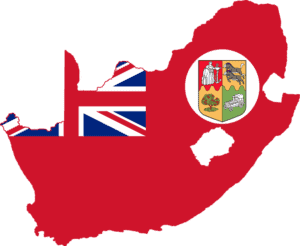
The British settlement of South Africa began with their conquest of the Cape Colony in 1795. The territory briefly returned to Dutch rule until it was occupied by the British in 1806. The Colony of Natal was annexed by Britain in 1843. The Transvaal and Orange River Colonies came under British rule in 1902. Several plans for the unification of the British colonies in southern Africa were proposed in the 1850s to 1870s, but it was in 1910 that the Union of South Africa was formed. In 1961, the Union became the Republic of South Africa and was pressured to leave the Commonwealth of Nations due to its insistence on adhering to its policy of apartheid.
Expansion of the British Empire in Africa
- Following the loss of the Thirteen Colonies as dictated by the Treaty of Paris of 1783, Britain’s imperial priorities began to turn towards Asia, the Pacific and Africa. The massive industrial revolution experienced in the 19th century enabled Britain to establish footholds on these continents.
British colonisation of Africa was pursued due to the following:
- Trade
- With the opening up of new routes inland and the subsequent discovery of minerals and resources, Britain saw the prospect of further trade and investment opportunities in Africa.
- African resources were sought to feed the demands of British industry.
- Moral duty
- Many British people during the Victorian era felt it was part of their moral and religious duty to spread their faith among non-Christians, or what they called ‘heathens’, in the belief that the Empire was a force for ‘civilisation’.
- Exploration
- Victorian explorers contributed to the increasing British interest in the continent through the publication of their findings and the spreading of tales of adventure.
- They were able to locate vast reserves of raw materials such as gold, palm oil and diamonds.
- British presence in Africa was determined more by trade than by sovereignty up until the second half of the 19th century.
- Britain’s formal control was initially concentrated in the West African settlements such as Sierra Leone and the Gold Coast, trading networks further inland and the Cape Colony in the south.
- This changed between 1857 and the 1890s as Britain sought imperial expansion across African territory in its desire to protect its existing possessions and improve the Empire’s economic influence.
British Expansion in Africa (1857–1890)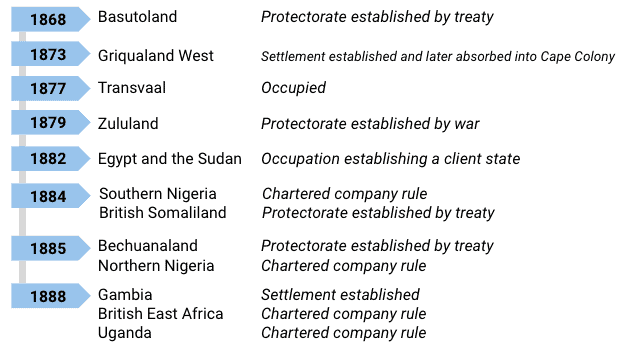
- Britain found a particular rival in France, which led to the formalisation of control of the former in areas where British traders had been operating. This was done by chartering companies, including the Royal Niger Company, the Imperial British East Africa Company and the British South Africa Company, to enforce British claims in the continent.
British colonisation of South Africa
- The British settlement of South Africa began with their conquest of the Cape Colony at the turn of the 19th century. The Cape Colony was founded in 1652 by the Dutch East India Company, which ruled over it until 1795. The British occupied the territory in order to better control the seas and prevent it from falling under the control of the French First Republic.
- In 1803, they ceded the colony to the Batavian Republic under the terms of the Treaty of Amiens, after which it returned to Dutch rule.
- After a temporary peace between Britain and France, the Cape Colony was occupied again by the British in 1806.
- At the time of British occupation, the white colonial population was scattered and amounted to no more than 25,000, with most residing in Cape Town and the neighbouring farming districts of the Boland.
- Britain initially intended to continue the existing arrangement in the colony. However, the British then decided to make English the official language of the law courts with the intention to convert the various European settlers to British culture.
- When the Napoleonic Wars concluded, the Cape Colony was formally ceded to Britain under the terms of the Anglo-Dutch Treaty of 1814.
- In around 1818, British emigration to South Africa started. The British colonists were urged to settle in the territory to expand the European workforce and to reinforce frontier regions against onslaughts from the Xhosa people.
- The British also began to introduce the first rudimentary rights for the Black African population in the territory, which were further fortified with the abolition of slavery in 1834.
- As a result, the Boer and Dutch settlers felt alienated, as more than 90% of grain and wine farms in the region were dependent on slave labour.
- The resentment felt by the Boers led them to leave the colony and trek north of the region en masse in what was known as the Great Trek. The Boers sought to settle inland and would later establish the Boer Republics.
- As British emigration carried on in the territory, many of the Boers also continued to trek inland.
Boer Republics founded in the 19th century:
- Natalia Republic
- Founded in 1839 after the Boer victory against the Zulus
- Annexed by Britain in 1843 to form the Colony of Natal
- South African Republic
- Also known as the Transvaal Republic
- Founded in 1852 following the Sand River Convention
- Orange Free State
- Founded in 1854 after the British relinquished their sovereignty under the Bloemfontein Convention
- In 1853, the Cape Colony became a British Crown colony with representative government, and its first Parliament was elected the following year. A period of peace and prosperity followed, especially after ethnic tensions weakened by the second half of the century. The colony also expanded in 1877 with its annexation of Griqualand West and Griqualand East.
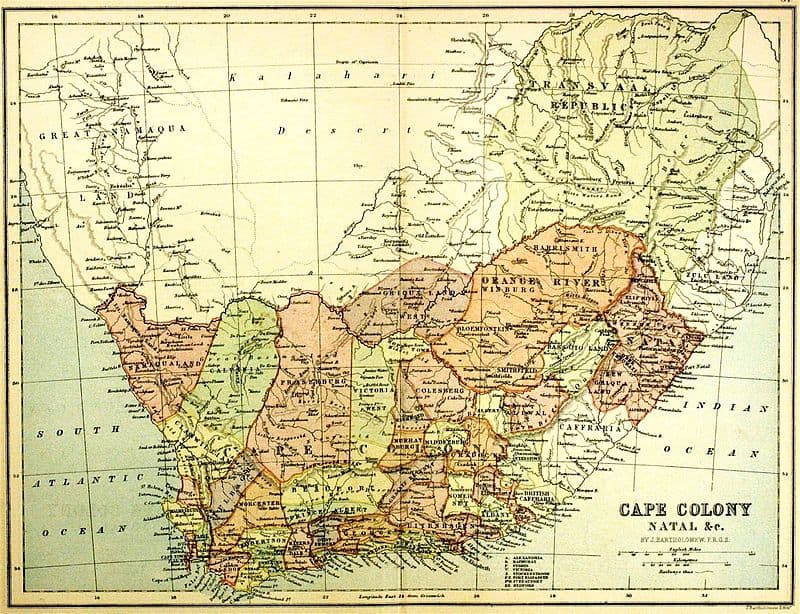
Map of the Cape Colony in 1876
Early attempts at unification
- For the most part, Britain recognised the autonomy of the Boer Republics of Transvaal and the Orange Free State. However, the relationship remained uneasy. In the second half of the 19th century, initiatives to unify the various states in southern Africa were carried out but were ultimately unsuccessful.
Sir George Grey’s South African Federation
- This idea was put forth by the Governor of Cape Colony, Sir George Grey, in the 1850s.
- He believed that political unity between the white-controlled states under British control would strengthen their position against the Indigenous peoples and other European powers.
- This was met with cautious optimism in the region, with the Orange Free State accepting the idea in principle.
- However, the British Colonial Office ordered Grey to abandon his plans.
Lord Carnarvon’s Confederation model
- The Secretary for the Colonies Lord Carnarvon sought to impose a system of Confederation on southern Africa in the 1870s.
- This, however, was largely rejected and viewed as unsuitable for the disparate entities of southern Africa. Both the Cape Colony and the Orange Free State disliked the idea.
Molteno Unification Plan
- In 1877, the Cape Colony’s Prime Minister John Charles Molteno, who believed in unification as a better political alternative than federalism, proposed the Molteno Unification Plan.
- This suggested the gradual cession of the smaller states to the Cape Colony and the extension of Cape’s liberal constitution and multiracial franchise to the other states of the union.
- This model was rejected by London.
Saul Solomon’s federation model
- Another prominent liberal politician of the Cape Colony, Saul Solomon, recommended an extremely loose system of federation with each state preserving its constitution and system of franchise.
- Solomon opposed Lord Carnarvon’s proposal.
- Solomon’s proposal was ignored by the Colonial Office.
The local proposals for unification were rejected, and Lord Carnarvon’s Confederation model pushed ahead. Consequently, the Boers of the Transvaal rebelled against this British annexation in what later became known as the First Boer War (1880–1881). Lord Carnarvon’s Confederation also resulted in the Anglo-Zulu War that occurred in 1879. The confederation plan was eventually abandoned.
Establishment of the Union of South Africa
- Thanks to their guerilla warfare tactics, the Boers won the First Boer War. The relationship between the Boer Republics and the British had been tenuous but deteriorated further with the discovery of gold in the Boer Republics in the 1880s. Thousands of British immigrants, including mineworkers, flocked to the gold mines, but they were subjected to unfair treatment from the Boers.
- Britain lobbied for the British mineworkers and pressured the Boer governments for concession.
- When they refused, the Second Boer War broke out in 1899.
- The early months of the conflict went badly for the British, with three key places – Mafeking, Kimberley and Ladysmith – under siege.
- The British were unprepared for the guerilla tactics used by the Boers, who were volunteer units, excellent horsemen and marksmen, knew the land very well and were indistinguishable from civilians.
- The Boers emerged victorious in most battles during late 1899 and early 1900, winning notable encounters at Magersfontein, Colesberg and Stormberg.
- Thousands of British reinforcements arrived as volunteers from across the British Empire supplemented the British war effort.
- The British reclaimed the captured towns and defeated the Boer troops in the field.
- The Boers refused to surrender and continued to engage in guerilla warfare under new leadership.
- The British then employed a scorched earth policy to impede the Boer forces. Around 30,000 civilian farms and 40 Boer towns were destroyed, leaving women and children homeless or sent to concentration camps.
- The death toll of the conflict was about 100,000, including the lives of 20,000 British soldiers and 14,000 Boer soldiers. The British concentration camps also added 26,000 casualties, mostly Boer women and children.
- In 1902, the Second Boer War concluded when the two Boer Republics signed the Peace of Vereeniging, agreeing to come under the sovereignty of the British Crown as the Transvaal and Orange River Colonies.
- The treaty formally provided eventual self-government to the Transvaal and Orange River Colonies, which they received in 1906 and 1907, respectively.
- In May 1908, a gathering of representatives from all four British colonies in southern Africa to discuss unification was proposed and supported by the colonies.
- The National Convention sought to come up with a solution to the political, racial and economic difficulties faced by the four colonies and find common ground between the Boers and the British.
- It was held between 1908 and 1909 in Durban, Cape Town and Bloemfontein.
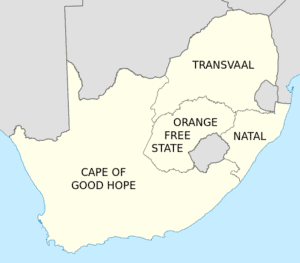
Map of South Africa with provincial borders - The convention resulted in the British Parliament’s passage of the South Africa Act in 1909, which ratified the Union of South Africa as a unitary state in 1910. The four colonies became the provinces of the Union. A bicameral Parliament was set up, consisting of the House of Assembly and Senate. English and Dutch were designated as the official languages of the Union. Additionally, the Act provided for possible incorporation of Rhodesia into the Union.
Development in the Union of South Africa
- The Union’s government structure was similar to the government of other British dominions. The British monarch was represented by the Governor-General, who held executive power. The office of Prime Minister was the head of government. Each province was supervised by an administrator, appointed by the central government.
- The first major piece of segregation legislation passed by the Union Parliament was the Natives Land Act of 1913. This severely restrained the ownership of land by Black people and stipulated that the Indigenous peoples were not allowed to purchase land from whites and vice versa. The amount of land reserved for Indigenous peoples was marginally increased thereafter.
- During the First World War, the Union joined the side of the Allies and participated in military operations against Germany. Hundreds of thousands volunteered and served in either German South-West Africa, East Africa, the Middle East, or on the Western Front in Europe. The Union made considerable contributions to the Allied war effort.
- The Union took over the administration of the German South West Africa after the territory was invaded by the Allies in the First World War. It was governed as South West Africa under a League of Nations mandate. Its incorporation into the Union was rejected by the United Nations.
- The 1922 referendum of Southern Rhodesia favoured responsible government instead of incorporation into the Union of South Africa. As a result, the administration of Southern Rhodesia passed from the British South Africa Company to the British Crown.
- The passage of the Statute of Westminster in 1931 led the Union to become fully sovereign from Britain. This abolished the last powers of the British Parliament to legislate on the Union.
- In 1934, the South African Party and National Party integrated to create the United Party, aiming for the reconciliation between the Boers and English-speaking whites.
- During the Second World War, the Union and its military forces made significant contributions in many theatres of the conflict including the North African, Italian and South African campaigns. About 334,000 men volunteered for the South African Armed Forces.
- After the National Party gained power in 1948, its all-white government enforced existing policies on racial segregation. The government adopted the policy of apartheid and passed laws on land, employment and housing that were advantageous to the white population compared to Black South Africans.
- In 1960, a referendum resulted in 52% of the population voting that the Union should be a republic. The Union became the Republic of South Africa on 31 May 1961. Even with the country’s shift from a monarchy to a republic, South African prime minister Hendrik Frensch Verwoerd promised that the state would stay within the Commonwealth of Nations. This was firmly opposed by the African States of the Commonwealth as well as Canada and India due to South Africa’s apartheid policy. As a consequence, South Africa withdrew from the organisation in 1961.
Image Sources
- https://upload.wikimedia.org/wikipedia/commons/thumb/4/4d/Flag-map_of_South_Africa_%281910%E2%80%931912%29.png/733px-Flag-map_of_South_Africa_%281910%E2%80%931912%29.png?20120907005345
- https://upload.wikimedia.org/wikipedia/commons/thumb/3/32/Cape_Colony_map_1876_-_Eve_of_Confederation_Wars.jpg/800px-Cape_Colony_map_1876_-_Eve_of_Confederation_Wars.jpg
- https://upload.wikimedia.org/wikipedia/commons/thumb/6/62/Map_of_the_provinces_of_South_Africa_1910-1976_with_English_labels.svg/800px-Map_of_the_provinces_of_South_Africa_1910-1976_with_English_labels.svg.png
Frequently Asked Questions
- What was the Union of South Africa?
The Union of South Africa was a self-governing British Dominion established in 1910, combining four British colonies: the Cape Colony, Natal, Transvaal, and the Orange Free State.
- What was the purpose of creating the Union of South Africa?
The creation of the Union of South Africa aimed to bring together the previously separate British colonies and Boer republics, fostering unity and stability in the region.
- Who were the major ethnic and political groups in the Union of South Africa?
The major ethnic groups included Afrikaners (descendants of Dutch settlers), British settlers, and various indigenous African communities. Politically, the union was dominated by the British and Afrikaner communities.

